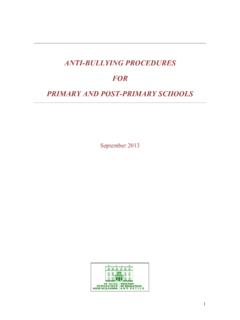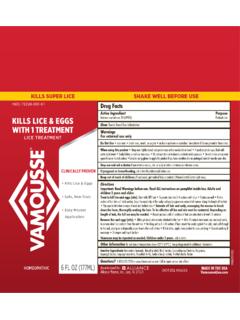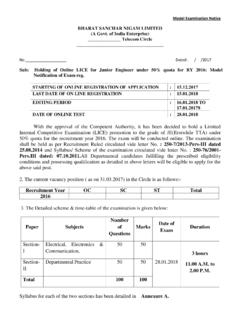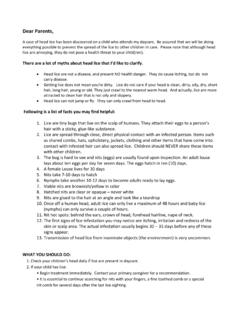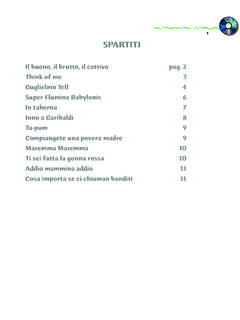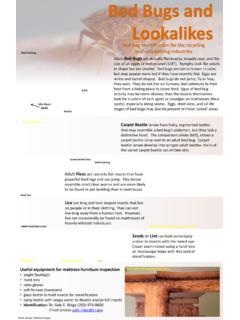Transcription of Public Health Medicine Communicable Disease Group
1 Management of Infectious Disease in SchoolsPublic Health Medicine Communicable Disease GroupOctober 2014 Table of ContentsAcknowledgements 3 Foreword 4 Chapter 1. Introduction 5 Chapter 2: Infection 6 What is an infection 6 Who is at risk? 6 How do infections spread? 6 Chapter 3: Prevention and Control 9 Background 9 Handwashing 9 Protective clothing 11 Personal hygiene 12 Respiratory hygiene and cough etiquette 12 Preventing blood and body fluid exposures 12 Management of cuts.
2 Nose bleeds and bites 13 How to manage a spill of blood or body fluids 14 Confidentiality 16 Resources 16 Chapter 4: Immunisation 17 Childhood Immunisation 17 Immunisation Schedule 17 Chapter 5: Staff Health 19 Adult Immunisation 19 Exclusion 19 Infectious Diseases Relevant to Staff 19 Special Circumstances 20 Chapter 6: Environmental Hygiene 22 Hygiene and the Environment 22 Cleaning 22 Disinfection 23 Toys and educational/recreational materials and appliances 24 Waste disposal 24 Chapter 7: Animals and Infection Control 26 Pet hygiene 26 Farm and zoo visits 26 Chapter 8.
3 High Risk Contact and Collision Sports 28 Background 28 General Precautions for all sports 28 Blood borne infections 28 Skin infections 29 Other infections 31 HSEM anagement of Infectious Disease in Schools -1-Management of Infectious Disease in Schools - October 2014 HSE-2-Chapter 9: Management of specific infectious diseases 32 Chickenpox / Shingles 33 Conjunctivitis 33 Diphtheria 34 Gastroenteritis/Food poisoning 34 Campylobacter 35 Cryptosporidium 35 Norovirus 35 Salmonella 35 Shigella 35 Verocytotoxigenic (VTEC)
4 36 Glandular Fever 36 Haemophilus influenza type b (Hib) 37 Hand, Foot and Mouth Disease 37 Headlice 38 Hepatitis A (Yellow Jaundice, Infectious Hepatitis) 38 Hepatitis B 39 HIV/AIDS Infection 39 Human Papilloma Virus (HPV) 40 Impetigo 40 Influenza and Influenza-like illness 41 Measles 42 Meningitis and Meningococcal Disease 42 Molluscum Contagiosum 43 Mumps 43 MRSA
5 (Methicillin-Resistant Staphylococcus aureus) 44 Pharyngitis/Tonsillitis 44 Pneumococcus 45 Polio 45 Respiratory Syncytial Virus 46 Ringworm ( Tinea ) 46 Rubella (German measles) 47 Scabies 47 Scarlet Fever/Scarlatina 48 Slapped Cheek Syndrome/Fifth Disease (Parvovirus B19) 48 Tetanus 49 Tuberculosis (TB)
6 50 Typhoid and Paratyphoid 50 Verrucae (plantar warts) 51 Viral meningitis 51 Whooping Cough (Pertussis) 52 Worms 52 Appendices Appendix 1: Schools on Private Water Supplies 54 Appendix 2: Hand washing poster: Wash your hands 56 Appendix 3: Hand washing poster: Be a germ buster 57 Appendix 4: Hand washing poster: Suds up and away 58 Appendix 5: Hand washing poster: 6 steps of hand washing 59 Appendix 6: Respiratory etiquette poster 60 Appendix 7: Contact Details for Public Health Offices 61 Appendix 8.
7 Sample notification letters to parents 62 HSEM anagement of Infectious Disease in Schools - October 2014 -3-Acknowledgements This document was produced by a subgroup of the Public Health Medicine Communication Disease Group (PHMCDG). This is a national Group of Consultants in Public Health Medicine with representation from each HSE Department of Public Health . Members of the PHMCDG SubgroupDr Fiona Ryan, Consultant in Public Health Medicine , HSE South (Chair)Dr Sinead Donohue, Consultant in Public Health Medicine , HSE SouthMs Helen Murphy, Infection Prevention and Control Nurse, HSE EastDr Mary Ward, Consultant in Public Health Medicine , HSE EastThis document builds on important, previously published Infection in School: A Manual for School Personnel (most recent edition 2005).
8 The original document was compiled by Prof Karina Butler, Consultant in Paediatric Infectious Disease , Our Lady s Hospital for Sick Children, and published by the Health Promotion Unit of the Department of Health in 1995. It was subsequently updated in 2005 with the assistance of the Infectious Diseases Group , Department of Public Health , South Eastern Health Board. 2. Management of Infectious Disease in Childcare Facilities and Other Childcare Settings ( ) This document was published in 2012 by the Scientific Advisory Committee of the Health Protection Surveillance Centre. We wish to thank the Scientific Advisory Committee for permission to adapt much of their material to make it relevant in the education setting. AcknowledgementsManagement of Infectious Disease in Schools - October 2014 HSE-4-Foreword Infectious diseases are a major cause of illness among school going washing is the single most important part of infection control.
9 Hence the importance of adequate hand washing facilities in all children the skills of hand washing and cough etiquette is essential in breaking the chain of infection, regardless of the vaccination of children, in line with the National Immunisation Guidelines, has resulted in fewer childhood illnesses. Schools are to be complimented for facilitating the Schools Immunisation control measures in schools will minimise transmission both within the school, but also to the wider would like to acknowledge the hard work of the Public Health Medicine Communicable Disease Sub- Group in producing this document. I am confident that it will be of great assistance to school personnel as they continue to play their role in controlling infectious time to time, there will be additions and links to other resources that relate to the management of infectious diseases in schools.
10 This material will be made available on the Health Protection Surveillance Centre (HPSC) website at is planned to formally review this document in Phil Jennings, Chair, Public Health Medicine Communicable Disease Group /Director of Public Health , of Infectious Disease in Schools - October 2014 -5-Chapter 1. IntroductionThese guidelines were designed to assist schools to prevent or minimise the spread of infection, illness and Disease to staff, pupils and others (such as student teachers and volunteers). They were primarily developed for use by teachers in primary and secondary schools. They aim to raise awareness about common and important infectious diseases and provide guidance on the prevention and management of infectious diseases in educational guidelines are based on best available evidence and consensus advice and support about specific infectious diseases can be obtained from Local Departments of Public HealthThe document provides advice on the prevention and control of the most common and important infections encountered in schools.
